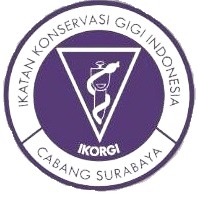Epigallocatechin-3-gallate (EGCG) and tricalcium silicate (C_3 S) combination as an antibacterial agent against Enterococcus faecalis
Downloads
Background: Dental caries affects 57.6% of the Indonesian population, with Enterococcus faecalis found in 80% of deep caries cases. Conventional materials used in vital pulp therapy (VPT), such as calcium hydroxide, have limitations including transient antibacterial action and poor sealing capacity. This prompts the exploration of alternative materials like epigallocatechin-3-gallate (EGCG), a polyphenol from green tea with antimicrobial activity, and tricalcium silicate (C₃S), a bioactive cement known for dentin regeneration potential. Purpose: This review evaluates the synergistic antibacterial potential of EGCG and C₃S combinations against E. faecalis, and assesses their feasibility as an alternative in VPT. Review: EGCG disrupts bacterial membranes, inhibits biofilm formation, and suppresses virulence factors, but lacks remineralization capability. Conversely, C₃S promotes dentin repair and creates an alkaline antibacterial environment, though its efficacy diminishes over time. Their combination compensates for each other’s limitations: EGCG enhances antimicrobial potency while C₃S provides long-term alkalinity and regenerative support. Conclusion: The EGCG–C₃S combination exhibits synergistic antibacterial and regenerative effects, offering a promising alternative to current VPT materials.
Marlindayanti SP, Hanum NA, Ismalayani SK, Heriyanto Y. Manajemen Pencegahan Karies. Lembaga Chakra Brahmana Lentera; 2022: 3-6.
Kementrian Kesehatan RI. Laporan Nasional Riskesdas 2018. Kementrian Kesehatan Republik Indonesia 2018; 179-217.
Rahardjo AK, Widjiastuti I, Prasetyo EA. Prevalensi karies gigi posterior berdasarkan kedalaman, usia dan jenis kelamin di RSGM FKG Unair Tahun 2014. Conservative Dental Journal. 2016; 6(2): 7-12.
Radman IK, Djeri A, Arbutina A, Milašin J. Microbiological findings in deep caries lesions. Serb Dent J. 2016; 63(1): 7-14.
Ahuja R, Gupta S, Nikhil V, Jaiswal S. Bioceramics in vital pulp therapy. Int J Res Rev. 2022; 9(5): 141-5.
Drouri S, Sy A, Jabri M. Evaluation of direct and indirect pulp capping with biodentine in vital permanent teeth with deep caries lesions. Cureus. 2023; 23;15(5).
Hanifah FA, Pertiwi ND, Agustantina TH. Combination calcium hydroxide and epigallocatechin-3-gallate in dentistry: A narrative. Indones J Dent Med. 2023; 6: 89-95.
Kwon YS, Kim HJ, Hwang YC, Rosa V, Yu MK, Min KS. Effects of epigallocatechin gallate, an antibacterial cross-linking agent, on proliferation and differentiation of human dental pulp cells cultured in collagen scaffolds. J Endod. 2017; 43(2): 289-96.
Ismiyatin K. Biodegrable Collagen, Hydroxyapatite, and Epigallocatechin-3-Gallate Hydrogel Scaffold as an Induction Material for Pulp Dentin Regenaration. Malaysian J Med Health Sci. 2023; 19: 48-5.
Liu Z, He X, Chen S, Yu H. Advances in the use of calcium silicate-based materials in bone tissue engineering. Ceramics Int. 2023; 49(11): 19355-63.
Janini AC, Bombarda GF, Pelepenko LE, Marciano MA. Antimicrobial activity of calcium silicate-based dental materials: A literature review. Antibiotics. 2021; 10(7): 865.
Zhang H, Tang B, Row K. Extraction of catechin compounds from green tea with a new green solvent. Chem Res Chin Uni. 2014; 30(1): 37-41.
Fadhilah ZH, Perdana F, Syamsudin RA. Telaah kandungan senyawa katekin dan Epigalokatekin Galat (EGCG) sebagai antioksidan pada berbagai jenis teh. Jurnal Pharmascience. 2021; 8(1): 31-44.
Reygaert WC. Green tea catechins: Their use in treating and preventing infectious diseases. BioMed Res Int. 2018; 2018(1): 9105261.
Mori GG, Teixeira LM, de Oliveira DL, Jacomini LM, da Silva SR. Biocompatibility evaluation of biodentine in subcutaneous tissue of rats. Journal of endodontics. 2014; 40(9): 1485-8.
Rajasekharan S, Vercruysse C, Martens L, Verbeeck R. Effect of exposed surface area, volume and environmental pH on the calcium ion release of three commercially available tricalcium silicate based dental cements. Materials. 2018; 11(1): 123.
Zhuang Y, Quan W, Wang X, Cheng Y, Jiao Y. Comprehensive review of EGCG modification: esterification methods and their impacts on biological activities. Foods. 2024; 13(8): 1232.
Esteki P, Jahromi MZ, Tahmourespour A. In vitro antimicrobial activity of mineral trioxide aggregate, Biodentine, and calcium-enriched mixture cement against Enterococcus faecalis, Streptococcus mutans, and Candida albicans using the agar diffusion technique. Dent Res J. 2021;18(1):3.

This work is licensed under a Creative Commons Attribution 4.0 International License.

CDJ by Unair is licensed under a Creative Commons Attribution 4.0 International License.
1. The journal allows the author to hold the copyright of the article without restrictions.
2. The journal allows the author(s) to retain publishing rights without restrictions










